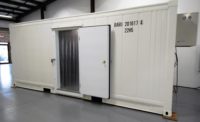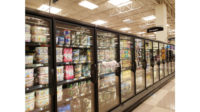This frost or ice buildup is a normal part of any freezer operation, and is removed by using heated defrost cycles at timed intervals. During normal operation, the amount of this buildup should not get to the point that problems will occur. However, in some abnormal circumstances, it can lead to problems.
When installing or relocating a freezer, it is important to consider where the unit will be located in the kitchen or space and how many times the door is open in a given time. The following are not good locations for a freezer installation: near commercial dishwashers; near heat-producing appliances such as grills, steamers, and fryers; and where evaporative coolers are the primary method for the make-up fresh air. Care should also be taken to ensure that a/c supply ducts or ventilation fans do not blow air directly into the box when the doors are opened. Not only do these items add additional moisture to the area, but they can also add considerable heat load as well.
Additionally, it is also important to properly level the unit. This will ensure proper door closure and condensation drainage and will keep water from accumulating and freezing in the drain pan.
Freeze-Ups
There are many reasons for reach-in evaporator freeze-ups. One of the more common problems is improper loading or over filling. Instruct the customer when loading or stocking a freezer that it is important that the product be free of any excess moisture and adequate space is left around the product so air can circulate through the compartment and evaporator. Box lids, plastic bags, or products should not restrict air circulation at the supply or return portals.
Some other common causes of freeze-ups include:
• Worn hinges not allowing the door to close properly,
• Infiltration from the compressor compartment,
• Outside ambient, and
• Loose, misaligned, or torn door gaskets.
Checking Gaskets
Door gaskets tend to be an area that receives a large amount of abuse. Although gaskets are designed to be recessed to reduce the amount of damage that they receive, eventually these gaskets will become damaged, allowing excessive moisture to enter the freezer. At this point, the gaskets must be replaced.
The most common way of checking the door gasket is by inserting a strip of paper (.003 mm) in different places around the door between the frame and gasket. The strip of paper should be slightly tight. If the paper falls out on its own, the door needs adjusting or the gasket needs to be replaced.
Lack of Airflow
Lack of airflow will lead to ice accumulation on the evaporator. Over time, depending on the environment and conditions, dust and airborne particles are pulled into the evaporator compartment, which can accumulate and clog the drain line or evaporator, leading to a freeze-up condition. These items should be checked; most can be easily cleaned or repaired during regular preventive maintenance.
Still other causes for freeze-ups are defective electrical components such as a defrost heater, door heater, evaporator fan motor, control board, etc.
If for any reason a freeze-up occurs, you can manually send the unit into defrost until all the ice is melted. After the unit has been in defrost for a few minutes, you can gain access to the evaporator compartment by opening the clamps around the evaporator cover or removing the top bolts on some models. After this cover has been removed, you can then check for a dirty evaporator or a restricted drain.
If the evaporator lid is difficult to remove, it may be frozen to the evaporator coil. Simply take a heat gun and force hot air through the supply and return air vents until the ice is melted or the lid can be removed. If the evaporator cover is plastic, take care not to overheat it.
After confirming that all the items above have been addressed, if you still have evaporator freeze-ups, it may be necessary to increase the number of defrosts per 24 hours. The number of defrosts can be adjusted on some models. Follow the instructions provided by the manufacturer to add additional defrost.
Publication date: 7/2/2012










